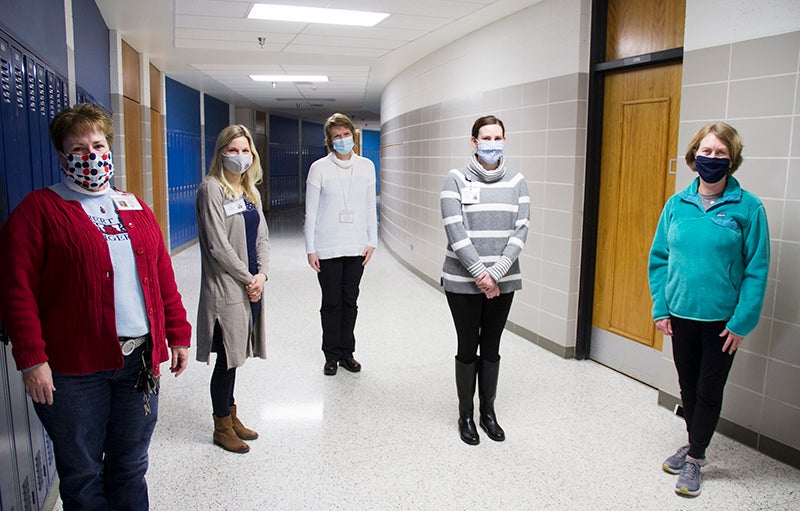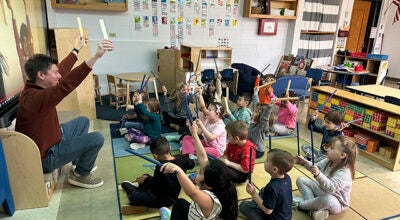Student safety at school
Published 9:13 pm Friday, January 29, 2021

- Albert Lea Area School licensed school nurses have been busy during the COVID-19 pandemic with many additional duties compared to most years. From left are Lisa Dugger, Kari Osheim, Jill Pryor, Lauren Smeby and Mary Appleton. Sarah Stultz/Albert Lea Tribune
|
Getting your Trinity Audio player ready...
|
Days are busy during the pandemic for school nurses
The role of a licensed school nurse in the Albert Lea school district has undoubtedly changed during the last year since the onset of COVID-19.
In addition to their regular duties, the nurses play an integral part in monitoring student health for COVID-19, conducting contact tracing to limit the spread when cases do arise and regularly working with district administration and local and state health officials.
Licensed school nurse Lisa Dugger, who has been with the district for 16 years, said the safety measures in place with the district have limited the number of cases to less than a handful in which the spread of COVID-19 can be directly traced back to the school setting.
As of Friday afternoon, the district has had 206 students or staff members who have had lab-confirmed cases, 11 of which are considered active.
‘Every situation is unique’
The district presently has one part-time and four full-time licensed school nurses. In addition to Dugger, who covers the high school, Area Learning Center and the 18 to 21 Transitions Program, Kari Osheim oversees students in Early Childhood and Southwest Middle School; Lauren Smeby oversees Hawthorne and Lakeview elementaries; Mary Appleton oversees Halverson and Sibley elementaries and Jill Pryor focuses on screenings and trainings.
Dugger said prior to 2016 the district had two licensed school nurses for all of the school buildings, but that expanded to three in the fall of 2016 and then expanded again to meet the increased need during the pandemic.
These days, the nurses’ days typically begin by following up on daily health screening questions answered about each student, including whether they have experienced any flu-like symptoms, if they have been exposed to someone with COVID-19 in the previous 24 hours and if anyone in their household is ill.
Colette Lillibridge, a licensed practical nurse, follows up for students in grades K-12 who answer yes to the second and third questions, and Appleton and Osheim follow up for the Early Childhood students.
For students who answer yes to experiencing any flu-like symptoms, the school nurses follow up on those directly.
Each case is handled individually, and they use a decision tree provided by the Minnesota Department of Health for both students and staff that helps them determine how to proceed given their scenario.
“Every situation is unique,” Dugger said. “We may have to have them go home if someone else is ill in their home or if someone is being tested.”
Throughout the day, they also follow up with the health clerks at the school to see if any students have symptoms they are exhibiting.
If they find out a student has tested positive, then comes the often difficult task of contact tracing, first figuring out if they had attended school during their symptomatic period. It becomes more challenging when students are asymptomatic.
At the elementary level, the Department of Health typically requires a whole classroom to quarantine because of the length of the day and how much the students move about the room. At the secondary level, due to shortened class periods and less activity in the classroom, there are often less contacts.
Dugger said the nurses go through the student’s schedule, set up Google Meets with the student’s teachers to figure out contacts and call the student and talk to family to try to figure out everything from how the student got to and from school, who they hung out with before school and who they sat with at lunch. Lunch is a difficult time because masks are removed to eat.
“Following up with one child could end up being hours,” she said.
The nurses said they get help from a few office staff at the high school who help with contacting families.
Smeby said at the elementary level, there could be as many as 20 contacts, while Dugger said at the high school level, it is averaging maybe three contacts — and that is usually the students they sit with at lunch. Those contacts go up when sports are involved.
They particularly consider students who have been within six feet of contact for 15 minutes or more.
They meet on a daily basis with the district’s COVID team, which reviews what is happening in the district and if they have to make any decisions. They look at things such as responses to screenings, the number of students out on quarantine and trends in the district and the county.
Smeby said they also regularly listen to Minnesota Department of Health webinars that update them on new policies and guidance and participate in Freeborn County level emergency preparedness meetings, as well.
‘We want to keep them healthy’
While their days are full, usually dealing with COVID-19 related issues, they still conduct their other duties, as well.
Pryor said each building has at least two first aid providers who are trained in CPR and first aid. Many of the schools also have licensed practical nurses in special education classrooms working with students with special needs, who also handle many health-related concerns that may arise throughout the day.
She said much of the scheduled school vision and hearing screenings that would normally take place are currently only happening individually as requested, which is also saving the nurses time for other duties.
Overall, the women said families have been understanding of the procedures and various mitigation measures that are in place during the pandemic.
“We understand this is hard for them, too,” Dugger said.
Osheim, who started in October and is in her first role in a school district, said she has been impressed with the dedication of teachers, administrators and fellow nurses.
“I think Albert Lea is really lucky to have great staff and educators who are truly passionate,” she said.
“There is a high priority on student and staff health,” Pryor added.
Osheim emphasized how vital the community’s role is in turn.
“What’s happening in the community is impacting whether we can keep our kids in school,” Osheim said. “It’s our top priority. We want to keep them healthy.”


